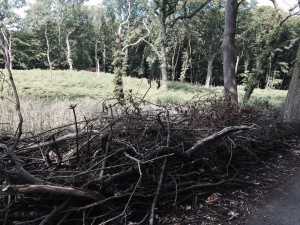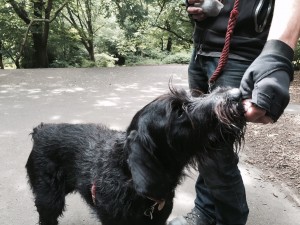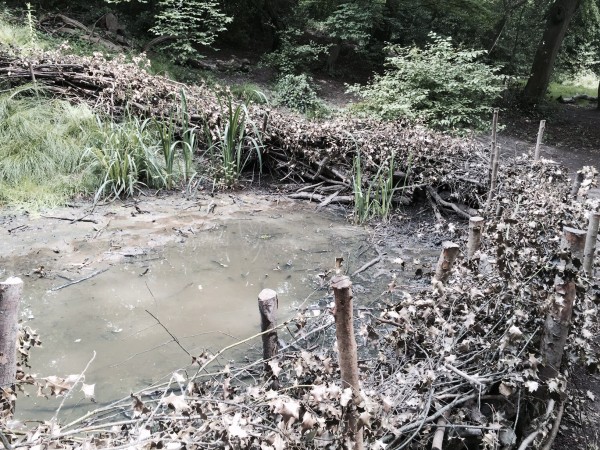Dead hedging : wildlife friendly and people guiding.

Dead hedges are piles of branches and twigs arranged to form a barrier which are increasingly used as a way to dispose of the material that arises from thinning or clearing operations in woodlands. Tree surgeons call this waste material of saplings and side branches "arisings" whereas foresters tend to call it "lop and top". Using surplus branches in this way is good for wildlife - especially for small mammals and birds - because it gives them somewhere to shelter that is protected from predators and from the wind and rain. It's also good for insects: dead hedges in effect create a linear eco-pile. Recently we at woodlands.co.uk have been using dead hedging as
- a way of guiding the public to stay on public footpaths and
- to discourage people from walking across sensitive areas of a woodland.
In many situations the dead hedge needs to have gaps left in it for deer paths and for managers and owners to get around the woodland.
 The idea is that the material in the dead hedge will rot away in ways that are good for ecosystems but this takes quite a few years as the branches are largely off the ground - it is becoming quite common to keep a dead hedge maintained by regularly putting more foliage and saplings on top. When constructing one of these barrier hedges you soon realise just how useful it is to build it very near to where the branches are, as an enormous amount of time and energy can be taken up in moving branches around your woodland. Depending on the site, the alternatives to creating a dead hedge are often unattractive - smelly bonfires, carting material off-site or leaving a forest-floor that is impenetrable by foot.
The idea is that the material in the dead hedge will rot away in ways that are good for ecosystems but this takes quite a few years as the branches are largely off the ground - it is becoming quite common to keep a dead hedge maintained by regularly putting more foliage and saplings on top. When constructing one of these barrier hedges you soon realise just how useful it is to build it very near to where the branches are, as an enormous amount of time and energy can be taken up in moving branches around your woodland. Depending on the site, the alternatives to creating a dead hedge are often unattractive - smelly bonfires, carting material off-site or leaving a forest-floor that is impenetrable by foot.
 Visiting a heavily used council woodland in Highgate in London recently I saw how effective dead-hedging can be in protecting areas of woodland from being trampled. Circular dead hedges were also being used to protect ponds from dogs - I saw a tightly built pile of cut branches woven between hazel posts which had created a barrier so that the tadpoles survived being persecuted by dogs - in this case labrador-German-wire-haired crossbreed.
Visiting a heavily used council woodland in Highgate in London recently I saw how effective dead-hedging can be in protecting areas of woodland from being trampled. Circular dead hedges were also being used to protect ponds from dogs - I saw a tightly built pile of cut branches woven between hazel posts which had created a barrier so that the tadpoles survived being persecuted by dogs - in this case labrador-German-wire-haired crossbreed.
Dead hedging is also a very useful activity for volunteer groups in woodlands because the activities involved are fairly safe - hand cutting of small diameter branches and arranging these into piles. Such projects have a clear purpose but also a very visible result so volunteers feel they have achieved something useful in building a dead hedge. Brambles that have been cut can also be put on top but often the dead hedge becomes a lattice work which will be colonised by brambles that are very much alive - much depends on how much light there is and whether brambles are already established in that part of the woodland.
Comments are closed for this post.
Discussion
Is it acceptable to weave in dead material into a layed hedge, particularly in areas where there is low light and the layed hedge struggles.
The hedges on our allotment site are gradually being layed and there were heated discussion on whether we should weave on cut material from other hedges.
Is it OK to put a dead hedge close to a ragstone wall?
I work in a school doing Forest School sessions and the exposed wall is getting damaged, so I was hoping a dead hedge could protect the wall as well as encourage wildlife.
I’m making a dead hedge at the bottom of my garden now. Great info and comments here. I can’t decide whether to use a line of bare leylandii trunks as the back line of the hedge and just add a line of posts in front to contain the cuttings. Can you advise please? Also wondering if the large quantity of sycamore off cuts I have piled up makes for suitable filling. Thanks.
How close to property is it advisable to have these dead hedges and snags in view of this summers heat wave and subsequent drought?
Does anyone know of a company / group of individuals who can be employed to create a dead hedge between the road of a private estate and the flanking woods?
We are near Kingston in Surrey.
I have inadvertently created a dead hedge along the foot of a live largely hawthorn hedge with not much lower growth, about 10m long. it is filled with woody trimmings collected for burning from about 75m of mixed wild hedge and shrubs around the garden (not laurel). Having read the above I intend to stake it, tidy up a bit and wait and see how it matures and what sort of wild life occupies it. Although rural here (W Dorset) I have not seen a hedgehog in the 10 years I have been here. Maybe the dead hedge will attract one or two. Any advice on construction and what trimmings not to have would be very welcome.
I created a ‘dry hedge’ in my parents’ garden. It’s located at the end of the garden is about 15 feet in length and about 5 feet in height. Behind it is a live hedge of 40 years old Leylandii. I created the dry hedge about 5 years ago . No cutting or garden waste ever leaves the garden , everything is placed in the hedge. We have Dunnocks, Wood Mice , Badgers , Red Foxes, Wrens all living in there and many invertebrates including multiple Bumblebee species that nest there. In the autumn many Newts appear to hibernate in the hedge.
It’s now naturally interwoven with Ivy which flowers late in the year providing important nectar for the pollinators and berries in the winter. In front of the dried hedge we also have created a ‘mini woodland’ with native woodland trees (Hazel, Holly and Oak) and multiple log piles. The sheer number of species in this small garden is mind blowing. I’ve also started to create a smaller version in my own garden in Chiswick.
Can I remind readers that making a dead hedge from native species may be beneficial to the environment and the ecosystem, but please be aware that some non native species when cut are poisonous to livestock (cattle and horses). In particular, I am referring to Laurel .
If you are considering having a dead hedge along your garden boundary please ensure that no livestock can have access to this, as you may become responsible for any arising issues.
I created a heap of dead branches in an area I wanted to fill up, and beside a hedgerow. I was amazed one morning to see a male female pheasant walk out from under it, just as any loving couple would. I had no idea I had created a place for these amazing creatures. How nature loves a mess, and how we can be overly tidy in our gardens sometimes.
I wonder if you could do this with leylandii. We have a row of perhaps 20 year old trees that are very bare at the base and too tall. I could cut them back to about 8ft and use the branches as infill. Only problem is that once the needles died it would look very messy. Could perhaps get ivy to grow through it.
This is a great idea in so many ways, but I’m thinking of a variation. We have a beech hedge along one side of our garden which is about 8ft high, but in the winter it loses all its leaves so that we and our neighbours lose much of our privacy. We are very fond of them but would still prefer a more permanent barrier.
I was thinking therefore of weaving dead branches, cuttings etc into the hedge to remedy this. Can anyone foresee any problems with this?
Have built a dead hedge to separate my garden from field next to andhide barbed wire on field owners fence. Owner is complaining that the sheep in the field will eat the branches and foliage from the dead hedge and could die. Is this true?
Thank you for sharing this information. I’m going to start a dead hedge in my parents orchard. We have red squirrels in the garden and a cat murderer occasionally…. I’m sure the dead hedge can only help the wildlife escape / stay safe :)
I am Chairman of Ashtead Rye Meadows and we are creating a book on the creation and running of the Meadows with a history through to anecdotes from volunteers. We’d like to do a chapter on Dead Hedges and have found the text on your website. Would you be happy for us to replicate these words in our book, referring of course to the source and the permission to reproduce from yourselves. I will add our own photographs of the dead hedges we have made, and perhaps a bit of local text relevant to our own resources. Many thanks.
David
I did this with my dead christmas tree and its very rustic and stays in place nicely also a great way to dispose of it in inner city gardening areas.
[…] that hawthorn forms a living hedge as opposed to one created from cut twigs and branches (i.e.a dead hedge). The common hawthorn (Crataegus monogyna) is found an understorey tree of woodland and has a […]
If building on a slope I would suggest the support posts are angled up the slope and if two parallel lines of posts are used as support they are lashed together to help counteract the weight on the supports.
It is worth checking that you aren’t covering valuable ground flora though
Cant wait to try my hand at this hedging come Autumn – hoping to protect my chestnut coppice area from deer – love the fact that nought is wasted, it can be artistically creative, beautifully rustic and supports a myriad of beings. Am going to invest in a post basher inner thingy with handles to make the job easier.
I love this idea!! Much better than fencing…
An excellent idea. Well worth advertising this!


Without fully realizing it to be a “dead hedge”, we’ve been doing this for years for about 50’ along the front as the old roadside fencing rotted away on our small acreage here in rural Vancouver Island, BC, Canada!
Instead of taking to the garden waste bin at our local municipal recycling centre a lot of branch prunings etc. from our front orchard and leylandii (castlewellan) hedge on another side of the property, we’ll now build a new “dead hedge” with supporting stakes between the sturdy trunks of two majestic very tall fir trees standing about 15’ apart at the top of our driveway here.
The resident quail, songbirds etc will love it! Also some extra protective shelter for them from our predating owls and other varied raptor population … although of course they have to eat too.
Thanks for the inspiration! :)
Joe Simpson
8 February, 2023